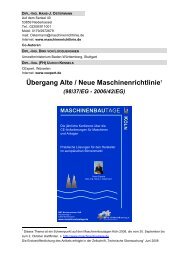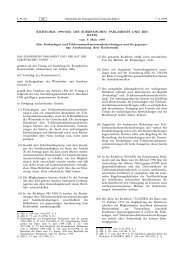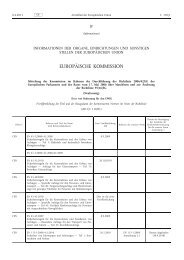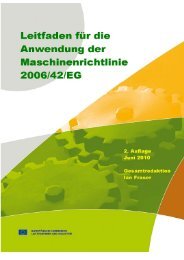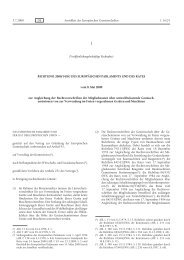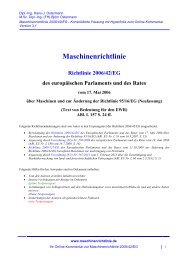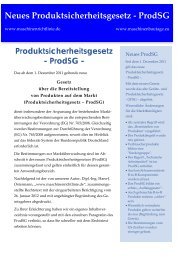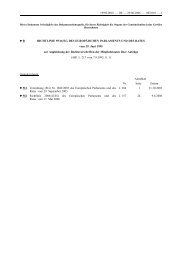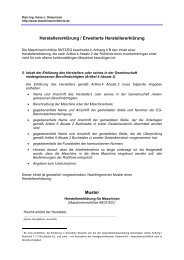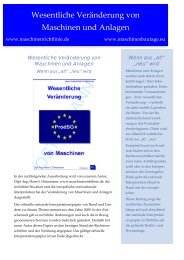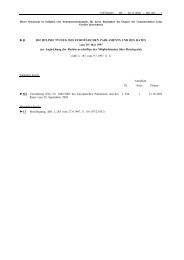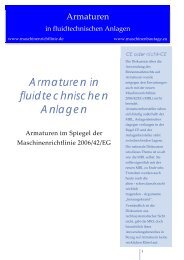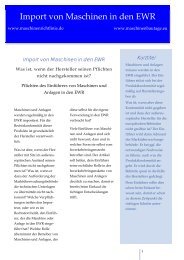Machinery Directive 2006/42/EC Closing of "loopholes" through ...
Machinery Directive 2006/42/EC Closing of "loopholes" through ...
Machinery Directive 2006/42/EC Closing of "loopholes" through ...
You also want an ePaper? Increase the reach of your titles
YUMPU automatically turns print PDFs into web optimized ePapers that Google loves.
Dannecker / Ostermann: Loopholes in the <strong>Machinery</strong> <strong>Directive</strong> <strong>2006</strong>/<strong>42</strong>/<strong>EC</strong>But the manufacturer <strong>of</strong> the partlycompleted machinery exposes himself toproduct liability law risks if he limits thedocumentation to be supplied with thepartly completed machinery to therequirements <strong>of</strong> Annex VI <strong>Machinery</strong><strong>Directive</strong>. Both the manufacturer liabilityunder tort law in accordance with § 823 (1)German Civil Code (BGB), and the liability<strong>of</strong> the manufacturer under the GermanProduct Liability Act (§ 3 (1) lit. a) ProdHGwhich is based on the Council <strong>Directive</strong>85/374/E<strong>EC</strong>) sanction faulty or the lack <strong>of</strong>operating instructions or instructions foruse and / or a lack <strong>of</strong> warnings againstpotentially hazardous properties <strong>of</strong> aproduct (keyword: "faulty instruction") 10 .The contract parties to the purchase <strong>of</strong>partly completed machinery are thereforewell advised to also include the point"operating instructions" in their contractdocuments. See also the "extendeddeclaration <strong>of</strong> incorporation" mentionedabove.The assessment <strong>of</strong> the contractconformity <strong>of</strong> the supplyWe should expressly point out once againhere:The CE marking on machinery / plantsmakes no statement about the (agreed)quality <strong>of</strong> a product. The CE marking hasto fulfil a different function, namely that <strong>of</strong>assuring the freedom <strong>of</strong> the movement <strong>of</strong>goods within the European single market.Thus it is like an “European-single-marketpassport”for goods and not a qualitysymbol with respect to safety.The assessment <strong>of</strong> the agreed condition /quality <strong>of</strong> a product, and hence thecontract conformity <strong>of</strong> the supply, isperformed purely under private law. If thepurchase is e.g. a commercial transactionfor both parties, the buyer must ensure inaccordance with § 377 GermanCommercial Code (HGB) that the goodsare examined for visible defectsimmediately on arrival in his "domain", and10 See www.maschinenrichtlinie.de under theheading "Produkthaftung” (Product liability)that notice <strong>of</strong> any defects discovered isgiven immediately.Failure to meet this obligation regularlyresults in the loss <strong>of</strong> the rights with respectto material defects, at least as far as thedefects not discovered or not reported areconcerned (the question as to what extentthe buyer can assign this obligation to theseller is not the subject <strong>of</strong> this paper).In the case <strong>of</strong> contracts for work (which isregularly the case for contracts for theconstruction <strong>of</strong> a complex machinery planttailored individually to the needs <strong>of</strong> theowner / buyer), the ordering party has toaccept the work manufactured by thecontractor:(§ 640 BGB)"Acceptance" means here the receipt <strong>of</strong>the manufactured work and itsrecognition as being in conformity withthe contract.In the case <strong>of</strong> contracts for the purchase <strong>of</strong>(individual) machine or partly completedmachinery, however, it is recommendedthat tests for the pro<strong>of</strong> <strong>of</strong> the agreedquality are also agreed. This can beachieved contractually <strong>through</strong> the termsfor the acceptance <strong>of</strong> the goods / services.In the case <strong>of</strong> long-term supplyrelationships it is recommended – also inthe light <strong>of</strong> minimising the product liabilityrisks – that "quality assuranceagreements" are concluded.A quality assurance agreement is to beunderstood as quality assurancemeasures contractually agreed with asupplier in which i.a. the following pointscan be defined in concrete terms: Quality goals for the individual parts /components Pro<strong>of</strong> <strong>of</strong> quality by the supplier, such ase.g. quality control measures to beperformed, presentation <strong>of</strong> testcertificates, etc. Quality assurance Exchange <strong>of</strong> quality data Demands on the supplier's qualitymanagement systems11



